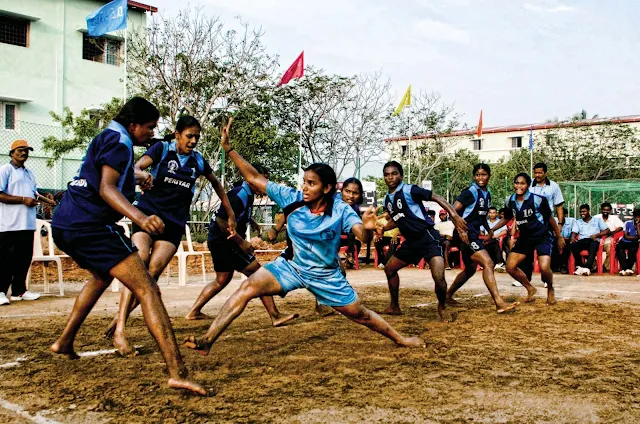Kabaddi's origins
Kabaddi's origins can be traced back to ancient times, with mentions of the game found in Indian scriptures and mythological texts. The word "Kabaddi" is believed to have been derived from the Tamil word "kai-piwi," which means "to hold hands." This reflects the essence of the game, where players hold hands and try to tag or touch their opponents while chanting the word "Kabaddi."
Historically, Kabaddi was played in various forms across different regions of India. It was not just a sport but also a way to enhance physical fitness, mental toughness, and camaraderie among communities. Villages and towns often organized Kabaddi matches during festivals and celebrations, turning the game into a cultural phenomenon.
As the popularity of Kabaddi grew, efforts were made to standardize the rules and regulations. The first attempt to create a unified set of rules for Kabaddi was made in 1918 when the Indian Kabaddi Federation was established. This marked a significant step in the formalization of the sport, providing a structured framework for competitions.
The advent of the 20th century
The advent of the 20th century saw Kabaddi gaining recognition as a competitive sport. Inter-village and inter-district tournaments became commonplace, attracting large crowds and fostering a sense of pride among participants. The game continued to evolve, with players developing specialized techniques and strategies to outsmart their opponents.
In the 1920s, the All India Kabaddi Federation was formed to streamline the organization of Kabaddi at the national level. This paved the way for the first national-level Kabaddi tournament in 1923, held in Baroda (now Vadodara). The tournament's success played a crucial role in establishing Kabaddi as a mainstream sport in India.
Over the decades, Kabaddi underwent further refinements in its rules and playing style. The game's format evolved, leading to the introduction of different variants such as Circle Kabaddi, Amar Kabaddi, and Gamine. Each variant had its unique set of rules, adding diversity to the sport and accommodating regional preferences.
The 1938 Indian Olympic Games in Calcutta included Kabaddi as a demonstration sport, marking another milestone in its journey to widespread recognition. The inclusion of Kabaddi in the Indian Olympics highlighted its cultural significance and showcased the sport to a broader audience.
Post-independence Kabaddi
Post-independence, Kabaddi continued to thrive, becoming an integral part of school and college sports programs. The sport's simplicity and minimal equipment requirements contributed to its accessibility, making it popular in both urban and rural areas. Kabaddi players started earning recognition and respect, and the game's appeal transcended regional boundaries.
The 1970s and 1980s witnessed the globalization of Kabaddi, with efforts to promote the sport internationally. The establishment of the Asian Kabaddi Federation in 1978 marked a significant step in this direction. Kabaddi started gaining popularity in neighboring countries, leading to the inclusion of the sport in the Asian Games in 1990.
The 20th century and early 21st century
The late 20th century and early 21st century saw Kabaddi experiencing a surge in popularity at the international level. The formation of the International Kabaddi Federation in 2004 further facilitated the global expansion of the sport. Kabaddi began to be featured in multi-sport events, including the Asian Games and the World Cup, providing a platform for players from different countries to showcase their skills.
The Pro Kabaddi League
One of the key turning points for Kabaddi was the introduction of the Pro Kabaddi League (PKL) in India in 2014. The league, with its franchise-based format and a mix of international players, brought unprecedented attention and financial support to the sport. The PKL not only elevated the status of Kabaddi in the Indian sports landscape but also attracted a global audience.
Conclusion
In conclusion, the history of Kabaddi is a journey of a traditional Indian game evolving into a widely recognized and celebrated sport globally. From its ancient roots to the vibrant contemporary competitions, Kabaddi's legacy reflects the resilience and adaptability of a sport deeply ingrained in the cultural fabric of India and beyond. The journey of Kabaddi is a testament to the passion of players, the support of fans, and the continuous efforts to promote and elevate the sport on the world stage.
FAQs:
What is the oldest name of kabaddi?
Indigenous to South Asia, kabaddi is also known as hu-tu-tu in western India, ha-do-do in eastern India and Bangladesh, chedu-gudu in southern India, gudu in Sri Lanka, and theechub in Thailand.
What is kabaddi called in English?
(kəˈbʌdɪ , kəˈbɑːdɪ ) noun. a game played between two teams of seven players, in which individuals take turns to chase and try to touch members of the opposing team without being captured by them.
Which countries play kabaddi?
The game in most popular and played in India, Nepal, Pakistan, Bangladesh, Japan, Sri Lanka, Thailand, Malaysia, Iran, Korea, Argentina, Canada, U.K, Italy, China, Trinidad and Tobago, Australia and many more countries.
What is the importance of kabaddi?
Since Kabaddi is mainly a game that requires a lot of physical effort and energy, playing this game will help children to be fit and healthy. They will also learn about endurance and defenses from breath holding and movement.
Who is known as kabaddi king?
Pardeep Narwal. Nickname(s) Dubki King, Record Breaker.
Nationality. Indian.










